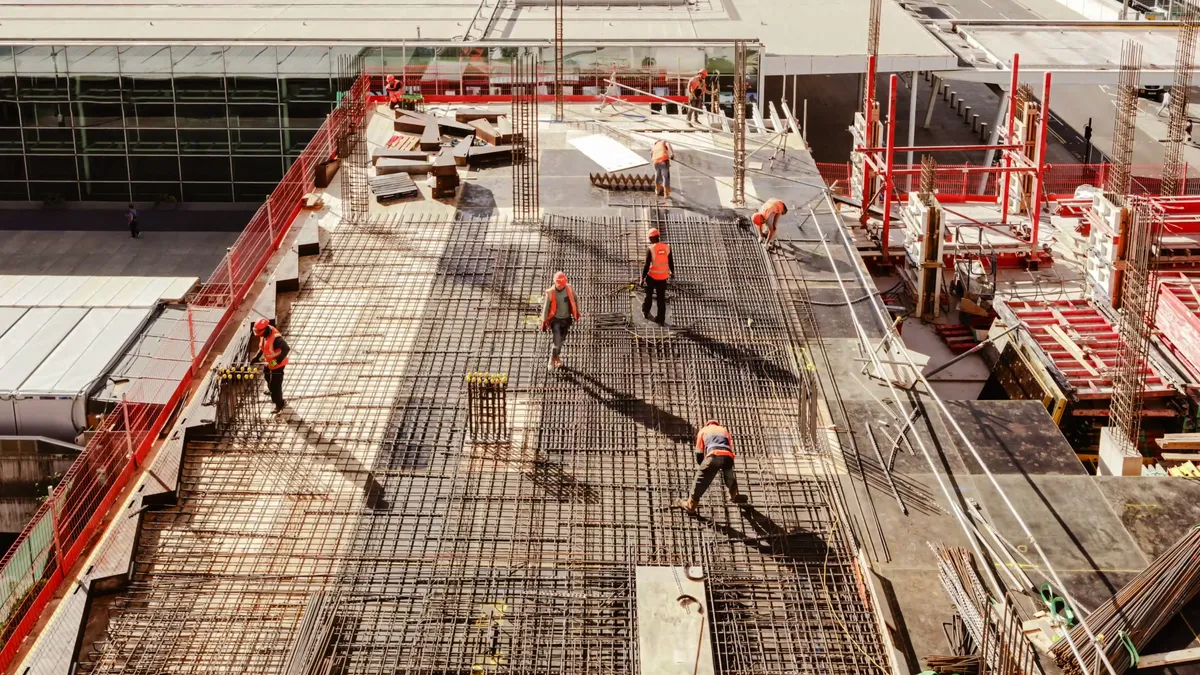As head of Ernst & Young’s global construction and engineering practice, Erin Roberts has kept a close eye on the market’s swings during the pandemic.
From the tax implications for contractors of federal infrastructure spending to materials hoarding during the worst of the supply chain snarls, Roberts has kept his finger on the pulse of construction throughout the crisis.

Now, as builders emerge from the pandemic but a possible recession looms, Roberts has been traveling the country to gauge how his construction clients are faring.
Construction Dive sat down with him to talk about the biggest challenges facing contractors and his outlook for the rest of the year.
Editor’s note: This interview has been edited for brevity and clarity.
CONSTRUCTION DIVE: We’ve been through a lot. COVID-19. Inflation. Rising interest rates. Where does the construction industry stand at the end of summer 2022?
ERIN ROBERTS: I was meeting with the clients this morning, and it was clear that the lag in development in high rise residential had a significant impact on their business. It brought their revenues down by half.
So, yes, there were pockets of the market that really suffered during this period.
But the reality is, the vast majority of other end markets have been continued to be strong. Our clients are continuing to build record backlogs, with high book-to-burn ratios. That’s nearly unanimous.
The broader markets continue to be flush with projects, and all the policy initiatives that the government has put in place, like the Infrastructure Investment and Jobs Act, the CHIPS Act and the Inflation Reduction Act, haven’t even really gotten started yet.
So there seems to be a very significant amount of opportunity for contractors moving forward.
What about the looming threat of recession we keep hearing about?
Construction is a cyclical business, so normally, I would say we should be battening down the hatches. But it feels like a different dynamic today, given that the demand for construction services ahead of us is so substantial at a time when backlogs are high and unemployment is low.
How has inflation and the rise in material costs affected your clients?
A lot of big projects were bid three years ago, when there was zero inflation. So they didn’t have contingencies and escalation clauses. So that’s been a big impact. Lump sum, design build and public-private partnerships have all clearly had profit fade associated with just the raw price of commodity increases.
But on the other side, as rents have risen, so have the revenue streams the developers are getting from the finished building. So that’s kept projects going.
What about the rise in interest rates? How does that impact government funding, if at all, versus private development money?
When it comes to direct allocation of funding to infrastructure projects generally, those dollars aren’t impacted.
But most of this funding gets deployed through a leverage factor, because every dollar of government funding is typically coupled with third-party debt and or equity capital.
So where you do see an impact of rising interest rates is on the cost of money associated with those funding mechanisms. And that could change an ROI for some of these major public-private partnerships.
Speaking of federal infrastructure projects, many contractors are staying away from mega projects, and the result has been just two or three bidders on many really big projects. Do you see that as a longer-term trend?
I do. We’re seeing a two-fold shift. Companies like Granite have gotten out of that big, large-scale, lump sum business. Many of the contractors that would have otherwise been in that market have opted out.
So the bidding table is someone like Tutor Perini and one or two big Spanish firms.
I think the productive shift there is a more towards a collaborative contracting model where it’s not a hard bid, it’s progressive design-build.
It’s, ‘Hire me to help you scope the project, and we’ll get the engineers and architects in here to dream it up, and then we’ll work with you under a provisional services agreement to give you a price you can count on.’
The IIJA passed 10 months ago. Where’s the money?
When the bill was passed, the Congressional Budget Office projected that they would deploy about $17 billion of IJ funds in their fiscal year 2022. That ends in a few weeks.
I was talking with one of our major engineering clients and they indicated they hadn't seen a single dollar come through, even on the engineering side, before any project.
I don’t think we’ve spent any of that money yet. We have seen green shoots at the agency level, looking to deploy those funds in the next six months and get the engineering side going. But construction is still going to lag that by another nine to 12 months.
Remember, this is is a five-year bill with a high water mark in the original estimates being 2026. I think now that’s maybe more like 2028. I’d say we’re looking at 2024 or 2025 before you start seeing meaningful construction spending in the $60 billion to $70 billion range.
You touched on the major government initiatives earlier. What additional opportunities do you see there?
Well, for one, the CHIPS Act on its face is $52 billion for grants associated with domestic chip manufacturing. But you have to remember, that’s an unleveraged number. The number you deploy in private capital is going to be ten times that, because these are really just credits and incentives to investment.
When you think of some of the announcements we’ve heard out of chip plants in places like Texas, that $52 billion is going to be leveraged to a significant amount of construction spending that’s going to move through the pipeline.




















